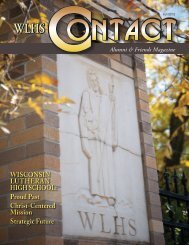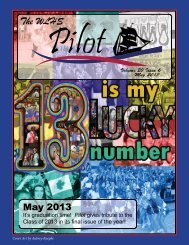Tim Thierfelder tim.thierfelder@wlhs.org 453-4567 x - Wisconsin ...
Tim Thierfelder tim.thierfelder@wlhs.org 453-4567 x - Wisconsin ...
Tim Thierfelder tim.thierfelder@wlhs.org 453-4567 x - Wisconsin ...
You also want an ePaper? Increase the reach of your titles
YUMPU automatically turns print PDFs into web optimized ePapers that Google loves.
ooUse the method of completing the square to transform any quadratic equation in x into anequation of the form (x – p) 2 = q that has the same solutions. Derive the quadraticformula from this form.Solve quadratic equations by inspection (e.g., for x 2 = 49), taking square roots,completing the square, the quadratic formula and factoring, as appropriate to the initialform of the equation. Recognize when the quadratic formula gives complex solutions andwrite them as a ± bi for real numbers a and b.A-APR.3. Identify zeros of polynomials when suitable factorizations are available, and use the zeros toconstruct a rough graph of the function defined by the polynomial.N-CN.1. Know there is a complex number i such that i 2 = –1, and every complex number has the form a +bi with a and b real.N-CN.2. Use the relation i 2 = –1 and the commutative, associative, and distributive properties to add,subtract, and multiply complex numbers.N-CN.3. (+) Find the conjugate of a complex number; use conjugates to find moduli and quotients ofcomplex numbers.N-CN.7. Solve quadratic equations with real coefficients that have complex solutions.N-CN.9. (+) Know the Fundamental Theorem of Algebra; show that it is true for quadratic polynomials.A-APR A-APR.5. (+) Know and apply the Binomial Theorem for the expansion of (x + y) n in powers of xand y for a positive integer n, where x and y are any numbers, with coefficients determined for exampleby Pascal’s Triangle. 1Unit Six: PolynomialsA-SSE.1. Interpret expressions that represent a quantity in terms of its context. ★ooInterpret parts of an expression, such as terms, factors, and coefficients.Interpret complicated expressions by viewing one or more of their parts as a single entity. For example,interpret P(1+r) n as the product of P and a factor not depending on P.A-SSE.2. Use the structure of an expression to identify ways to rewrite it. For example, see x 4 – y 4 as (x 2 ) 2– (y 2 ) 2 , thus recognizing it as a difference of squares that can be factored as (x 2 – y 2 )(x 2 + y 2 ).A-APR.1. Understand that polynomials form a system analogous to the integers, namely, they are closedunder the operations of addition, subtraction, and multiplication; add, subtract, and multiply polynomials.A-APR.2. Know and apply the Remainder Theorem: For a polynomial p(x) and a number a, the remainderon division by x – a is p(a), so p(a) = 0 if and only if (x – a) is a factor of p(x).A-APR.3. Identify zeros of polynomials when suitable factorizations are available, and use the zeros toconstruct a rough graph of the function defined by the polynomial.A-APR.4. Prove polynomial identities and use them to describe numerical relationships. For example, thepolynomial identity (x 2 + y 2 ) 2 = (x 2 – y 2 ) 2 + (2xy) 2 can be used to generate Pythagorean triples.A-APR.5. (+) Know and apply the Binomial Theorem for the expansion of (x + y) n in powers of x and y fora positive integer n, where x and y are any numbers, with coefficients determined for example by Pascal’sTriangle. 1
















